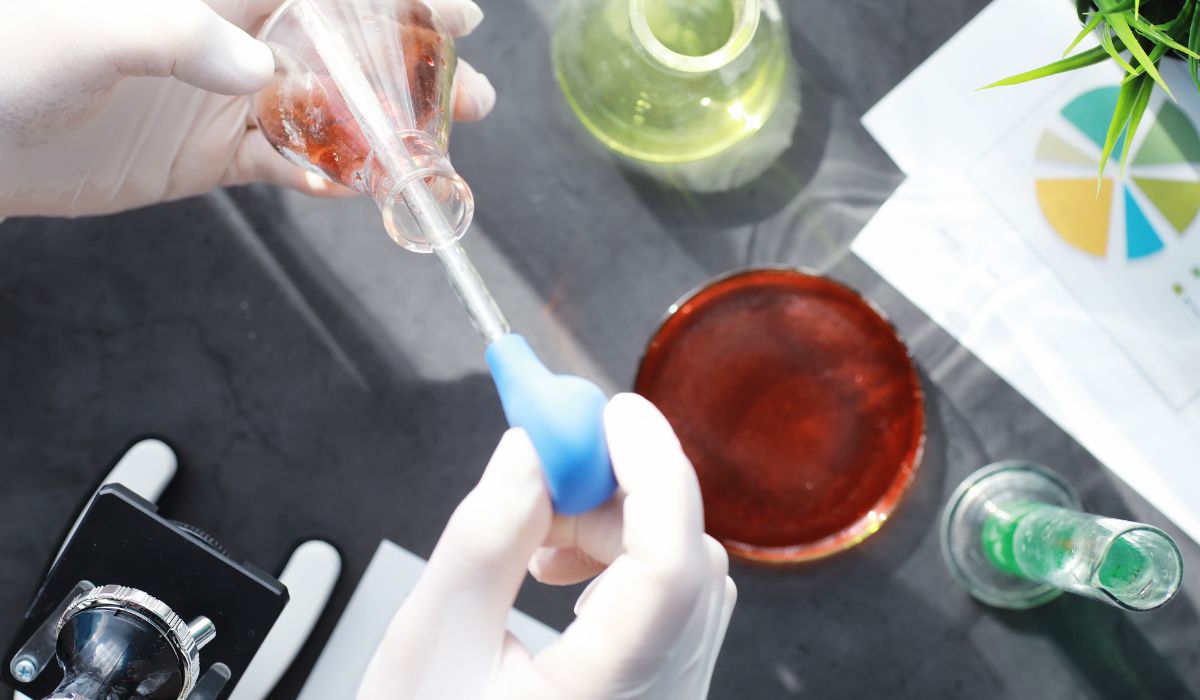What Is MDPV?
MDPV stands for 3,4-methylenedioxypyrovalerone. It is a man-made drug often sold as “bath salts.” It does not go in your tub. It goes into a person’s body and can cause strong, risky effects. MDPV is part of a chemical group called cathinone. Cathinones are stimulants. They can make the heart race and the mind speed up.
Why people worry about it
MDPV can lead to addiction and dangerous behavior. Some people feel psychomotor agitation (they can’t sit still), fast speech, or even delirium (confused thinking). These effects can harm your health and safety.
Is it legal?
The Drug Enforcement Administration (DEA) lists MDPV as a Schedule I drug. That means it has a high chance of abuse and no approved medical use. Because of this, many workplaces, treatment centers, and courts want to know if MDPV shows up on a drug test.
Does MDPV Show Up on a Drug Test?
The short answer
Yes, MDPV can show up on a drug test, but it depends on the kind of test. Not every basic, low-cost test looks for MDPV. Many “standard” cup tests check for drugs like amphetamine, phencyclidine (PCP), THC, cocaine, and opioids. Some basic panels do not include cathinones.
The long answer
Modern labs, like Lynk Diagnostics, can test for MDPV when asked or when a panel includes synthetic cathinones. We use advanced tools in forensic toxicology and clinical toxicology to confirm what’s really there.
What Kinds of Tests Can Find MDPV?
Screening tests (first look)
Many programs start with a urine screen. This is a quick test that looks for groups of drugs. Some screens include a cathinone line. Others do not. A screen is helpful, but it can miss things or give a result that needs double-checking.
Confirmatory tests (gold standard)
When a screen is positive or unclear, a lab uses chromatography and mass spectrometry to confirm. These are precise methods that separate and identify chemicals.
- Gas chromatography (GC) separates parts of a sample.
- A quadrupole mass analyzer (part of a mass spectrometry system) weighs tiny pieces of the drug molecules.
- Together, GC/MS (gas chromatography–mass spectrometry) or LC-MS/MS (liquid chromatography with tandem mass spectrometry) give a reliable answer: is MDPV present, and how much?
At Lynk Diagnostics, our medical laboratory team uses these tools to make sure final reports are accurate and easy to understand.
How Long Is MDPV Detectable?
Typical urine detection window
Detection time can change from person to person. Body size, liver function, dose, and hydration can all play a role. In many cases, urine may show MDPV or its breakdown products for about 1–3 days after use. Heavy or frequent use may last longer. Light or one-time use may be shorter.
Other specimens
- Blood tests have a shorter window but can show current or very recent use.
- Oral fluid (saliva) can also detect recent use.
- Hair testing (when included) can show use over a much longer time.
Ask your program which sample type they use. Lynk Diagnostics can help explain each option.
What Does MDPV Do in the Body?
Basic pharmacology and pharmacodynamics (kept simple)
Pharmacology is how drugs act in the body. Pharmacodynamics is what those drugs do to you. MDPV is a strong stimulant. It can raise heart rate and blood pressure. It can change mood, focus, and body reflex responses. At high doses, it may cause anxiety, panic, shakiness, or delirium. Mixing MDPV with alcohol or other drugs can make risks even higher.
Metabolism
Your liver helps break down MDPV into smaller pieces, called metabolites. Labs can measure the parent drug and these metabolites to confirm use. That is why mass spectrometry and chromatography matter—they can see the small details clearly.
What Do “Bath Salts” Mean on a Report?
“Bath salts” ≠ bath products
On a lab report, “bath salts” usually refers to synthetic cathinones like MDPV, mephedrone, or methylone. These are not products for skin care. They are designer drugs.
Why names are confusing
Street names change often. Packages may say “not for human consumption,” “plant food,” or “research chemicals.” This is done to hide what’s inside. Because of this, testing with forensic toxicology methods is important. It helps programs know what is really in the sample.
Will a Regular 5-Panel or 10-Panel Test Catch MDPV?
It depends on the panel
Some common panels do not include cathinones by default. Many panels check for amphetamine, phencyclidine, opioids, cocaine, and THC. To detect MDPV, programs often add a cathinone panel or request a targeted test. Lynk Diagnostics offers panels designed for rehab facilities, where synthetic drugs are a concern.
Confirm to be sure
If a program suspects bath salts use, it’s smart to request GC/MS or LC-MS/MS confirmation. These methods can distinguish MDPV from other stimulants or look-alikes, reducing false positives and giving a clear, final answer.
Tapentadol vs. MDPV: Why They’re Different (But Both Are Tested)
Two very different drugs
Tapentadol is a prescription opioid pain medication. MDPV is a synthetic cathinone stimulant, often sold as bath salts. They act very differently in the body and on the brain.
Why we mention tapentadol
In drug testing, panels often include opioids (which can include tapentadol when specifically ordered) and may add a cathinone panel for MDPV. A strong testing strategy looks at both sides: depressants like opioids, and stimulants like cathinones. Lynk Diagnostics builds panels that match your program’s needs, including targeted testing for tapentadol and MDPV when appropriate.
What Can Cause a Positive or Negative Result?
Reasons a result may be positive
- The person used MDPV within the detection window.
- The screen was positive, and confirmation by gas chromatography and mass spectrometry matched MDPV or its metabolites.
Reasons a result may be negative
- The person did not use MDPV.
- The person used MDPV outside the detection window.
- The panel did not include cathinone testing.
- The sample was too diluted to detect the drug.
Why confirmation matters
Only confirmation with chromatography and mass spectrometry can say for sure. A quadrupole mass analyzer in the instrument helps the lab identify the exact chemical “fingerprint.” This protects patients, programs, and families from confusion.
Safety Notes and Health Risks
Short-term risks
MDPV can cause fast heart rate, high blood pressure, sweating, tremors, psychomotor agitation, and delirium. It can also cause panic, risky choices, and poor sleep.
Long-term risks
Repeated use can lead to addiction and mental health problems. It can strain the liver and heart. Mixing with alcohol or other drugs raises the danger.
If you need help
If you or someone you love is struggling, please reach out. Lynk Diagnostics partners with rehab facilities and care teams to support testing, therapy planning, and follow-up.
How Lynk Diagnostics Can Help
Clear answers, fast
We provide urine testing with screening and confirmatory methods, including GC/MS and LC-MS/MS. Our medical laboratory explains reports in plain language and supports your program’s policies.
Rehab-focused panels
Because we serve rehab facilities, our panels can include cathinones (like MDPV), tapentadol when requested, stimulants (such as amphetamine classes), and other key drug groups. Your team gets the data needed to make safe, fair decisions.
Step-by-Step: What Happens in Testing?
1) Collection
A urine sample is collected following chain-of-custody rules.
2) Screening
The sample is screened. If cathinone screening is included and shows a reaction, the sample moves to confirmation.
3) Confirmation
The lab uses chromatography and mass spectrometry. The quadrupole mass analyzer helps match the exact pattern of MDPV or its metabolites.
4) Review
A toxicology expert reviews the data. In forensic toxicology, we look closely at cutoffs, quality controls, and any interferences. We confirm the final result.
5) Report
You receive a clear, simple report. If needed, Lynk Diagnostics can speak with your care team and answer questions about the findings.
Common Myths About MDPV and Drug Tests
“Drinking lots of water will hide it.”
Too much water may dilute urine, but labs can see that. It may lead to an invalid or suspicious result, not a clean one.
“MDPV looks the same as other drugs on tests.”
Good labs use GC/MS or LC-MS/MS to tell drugs apart. That is why confirmatory testing matters.
“If the screen is negative, there’s no MDPV.”
Not always. If your panel doesn’t include cathinones, the screen can be negative even if MDPV is present. Ask for the right panel.
FAQs
How long does MDPV stay in urine?
For many people, 1–3 days is typical, but it varies. Body size, dose, and liver function matter. Heavy use can last longer; light use may be shorter.
Can a basic 5-panel test find MDPV?
Often no. Many basic panels do not include cathinone testing. Ask for a panel that includes MDPV or request confirmatory testing.
What is GC/MS and why is it important?
Gas chromatography–mass spectrometry separates and identifies chemicals. The quadrupole mass analyzer helps confirm the exact drug. This method is trusted in forensic toxicology because it is accurate and specific.
Can MDPV cause false positives for other drugs?
A quick screen might react in broad ways, but confirmation by chromatography and mass spectrometry will tell the drugs apart. That is why labs confirm screens before finalizing a report.
Is tapentadol the same as MDPV?
No. Tapentadol is a prescription opioid used for pain. MDPV is a synthetic cathinone stimulant often called bath salts. They are different drugs, and labs test for them using different targets.
Key Takeaways
- Yes, MDPV can show up on a drug test, but your panel must include cathinones or use targeted testing.
- Urine is commonly used. Many cases show a window of 1–3 days after use.
- The most reliable methods are chromatography and mass spectrometry (like GC/MS or LC-MS/MS) with a quadrupole mass analyzer.
- MDPV can harm your health and may cause psychomotor agitation, anxiety, or delirium.
- For clear answers, work with Lynk Diagnostics, a drug testing center dedicated to rehab facilities.
Talk with Lynk Diagnostics
Whether you run a rehab program, need a special panel, or want help understanding toxicology reports, we’re here. We explain complex pharmacology terms in simple words. We confirm results with strong science. And we support your therapy and recovery goals every step of the way.








